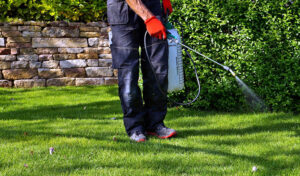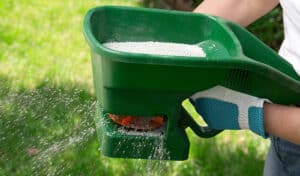Do you wonder what those spots are in your lawn that shows up every July/August? Typically the spots are about 1′ to 2′ circles with green grass in the middle. This is a very difficult disease to get rid of in your lawn.
Necrotic Ring Spot (NRS) is a fungal disease that primarily affects the roots of turfgrasses. The disease occurs on turfgrasses worldwide. Many turf species can serve as host to the disease. In Utah, the disease primarily affects Kentucky and annual bluegrass turf, although it can occur on tall fescue grass as well. Other diseases can be confused with necrotic ring spot; therefore, an accurate diagnosis by a trained diagnostician is crucial to identifying the pathogen to properly address the management of the disease. Management of this disease is difficult and requires an integrated approach utilizing cultural, chemical, and varietal control measures.
Management practices that reduce stress on turfgrass, such as watering turf to avoid drought stress, will also help suppress necrotic ring spot. Normally, lawns should be watered deeply and as infrequently as possible without creating stress from overwatering. In the presence of necrotic ring spot, however, frequent watering will cool the grass and allow infected plants with depleted root systems to survive the late afternoon heat. Light applications of water can be applied daily to infected turf in hot weather to reduce heat stress and initiate recovery. Care should be taken to prevent over-watering. Compacted soils are more favorable for this disease to occur as well. Thus core-aeration, with clean equipment will help minimize soil compaction.
Avoid nutrient deficiencies and maintain a balanced fertilization program, particularly for nitrogen,
phosphorus, and potassium. The severity of necrotic ring spot is reduced when slow-release forms of fertilizers specifically nitrogen are used rather than quick-release forms. This allows for a more uniform release of nutrients
throughout the season and avoids the bursts of growth following fertilizer application. Recent research in Colorado
suggests that formulations of sulfur coated urea (SCU) and applications of elemental sulfur as a soil amendment,
help to suppress the disease. Lawns should be cut so the grass is 2.5 to 3.5 inches high.
(some information is taken from http://extension.usu.edu/files/publications/factsheet/necrotic-ring-spot08.pdf)






